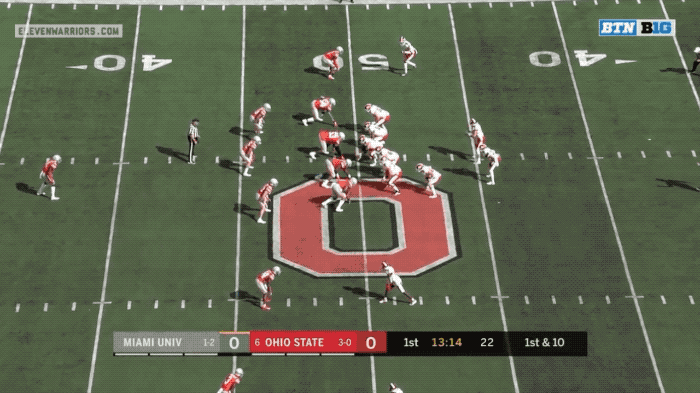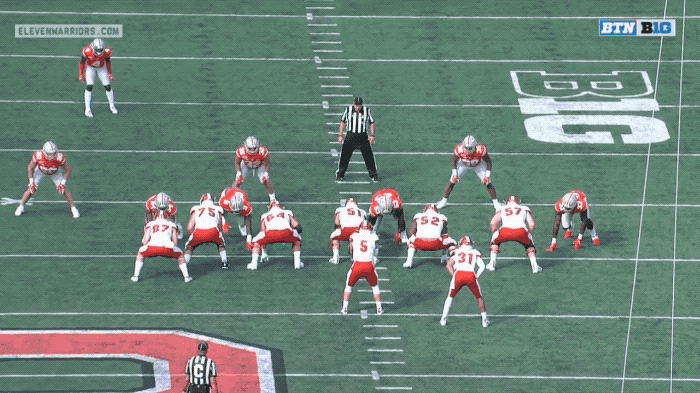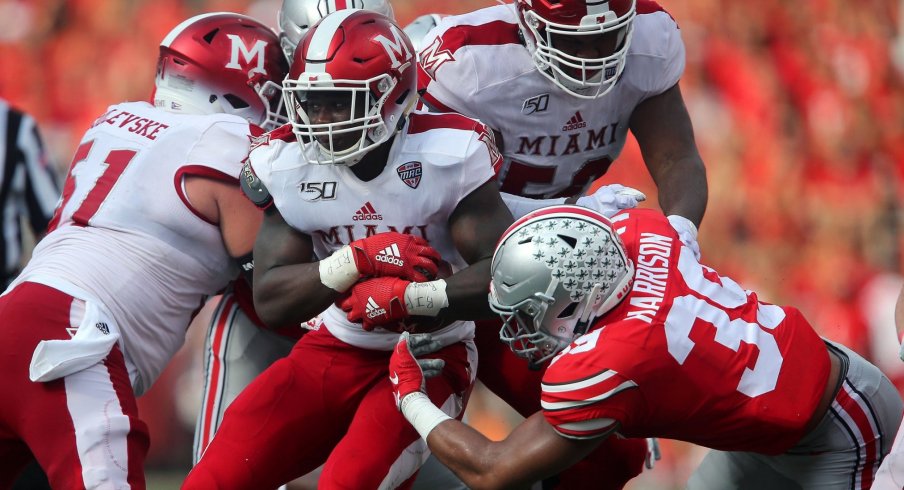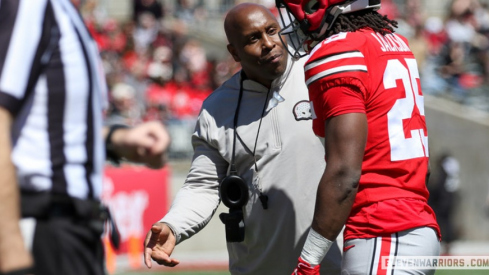After two games, I declared in this very space that "The Silver Bullets are back," only to be told by cautious readers that the sample size was far too small. Now, even though many fans are still settling into their game day routines, Ohio State is one-third of the way through their 2019 regular season, meaning it's fair to judge the results in front of us.
In their four contests, the new-look Buckeye defense from coordinators Greg Mattison and Jeff Hafley appears to not only be improved from last season but to be one of the nation's best, especially when it comes to stopping the run. As of today, they sit second nationally in total defense, allowing just 222 yards-per-game, thanks in large part to a stingy run defense that has surrendered just 1.71 yards-per-carry, trailing only Wisconsin in both categories.
Not every statistic correlates toward success, but it's worth noting that the last two national champions, Clemson and Alabama, finished with the top mark nationally in yards-per-carry allowed in those seasons. For the Buckeyes to reach their ultimate goal of raising the CFP trophy, this is one area in which they must remain elite.
While it's true that they've yet to encounter a top-tier opponent, the Buckeyes have handled their business in a way that's totally counter to last year. In 2018, they held just one opponent, Rutgers, below 3.0 yards-per-carry, on their way to allowing an average of 4.52 ypc and ranking 79th nationally.
Such a drastic change can lead many to wonder how such a change could take place so quickly. As we heard all offseason from the entire defensive staff and head coach Ryan Day, the new system was supposed to allow the unit to simply play faster and more aggressively.
In Greg Schiano's man-coverage system, shifts and motions were handled by the entire back-seven. This meant linebackers and defensive backs could be easily manipulated to line up far from the ball in fear of giving up an easy pass, resulting in countless mistakes and mismatches.
This season, thanks to a zone-centric coverage philosophy, Buckeye linebackers have been allowed to focus primarily on stopping the run, leaving the secondary to handle any quick passes with a conservative shell over the top. This allows the linebackers to play 'downhill' at the first sign of a run, filling their assigned run gaps with aggression.

"Just being physical at the point of contact and being nasty," middle linebacker Baron Browning said of the guidance he and his teammates have received, following the 76-5 shellacking of Miami (Ohio). "Just being felt every play, and sending a message every play. I think that's something that's resonated a lot and something we try to focus on."
Time after time, OSU 'backers can be seen shooting gaps as soon as they come open, taking away running lanes before runners can even find them. This is also a subtle difference from a season ago, when the same players would shuffle and try to mirror the steps of the running back instead of coming forward.

Additionally, with eyes in the backfield instead of chasing receivers, there are always multiple defenders rallying to the ball instead of just one or two players making a tackle. While the scheme certainly helps, such play is also a mentality that has been ingrained for months.
The result has not only led to success for the unit but some gaudy stats for individuals as well. In 14 games last fall, WILL linebacker Malik Harrison registered 8.5 tackles-for-loss. Through 4 games this season, he's already totaled 7.0, tallying at least one in every game despite sitting for most third and fourth quarters.
To say this success against the run is due only to the play of the linebackers or scheme in the secondary would be unfair, as the defensive line has been dominant in their own right. Sure, Chase Young may be having the best season of any single player in college football, but interior players like Davon Hamilton and Jashon Cornell have been nearly unblockable at times, allowing Harrison and others to pack the stat sheet.

As one might expect, Day may be pleased but still believes his defense has room for improvement.
“We’re playing tough, we’re playing hard, we’re tackling well, we’re running to the ball, we’re playing with good emotion,” Day said. “Watching the film, there’s so many things to clean up. You can overcome a bunch of that stuff with effort and with toughness, and that’s what we’re doing right now. But if we want to get to where we need to get, we need to make sure we clean up a lot of these things.”
One reason for this belief may be the way Miami converted multiple third downs. With the linebackers flowing downhill so fast at the first sign of an inside zone run, the Redhawks quickly changed direction, executing a speed option which pinned the outside linebacker inside and left the end to defend two potential ball-carriers.

"That's actually not an option play," Day noted after the game, as the quarterback's job is simply to hold the end before pitching. "It's another type of play that we'll have to work on. They hit us, I think, three different times on that."
After the Redhawks found some success with the scheme, there's no question that the Buckeyes will see it again in coming weeks, along with a host of other constraint plays meant to capitalize on the defense's aggressive play against the run. Instead of continuing to build the foundation, however, Day's staff can now focus on anticipating the wrinkles that will come their way.
"There's going to be some things on film that we can really look at and figure out how other teams are going to be attacking us and make sure we have the ammo to come at them with."
Mattison, on the other hand, was a bit more liberal when it came to handing out praise after his team's fourth-straight dominant performance.
"All I know is ever since spring football, I've been really impressed," he said following the Miami win. "I love our work ethic, I love how hard our players play. I love how important it is to them. This just shows what I thought.”



